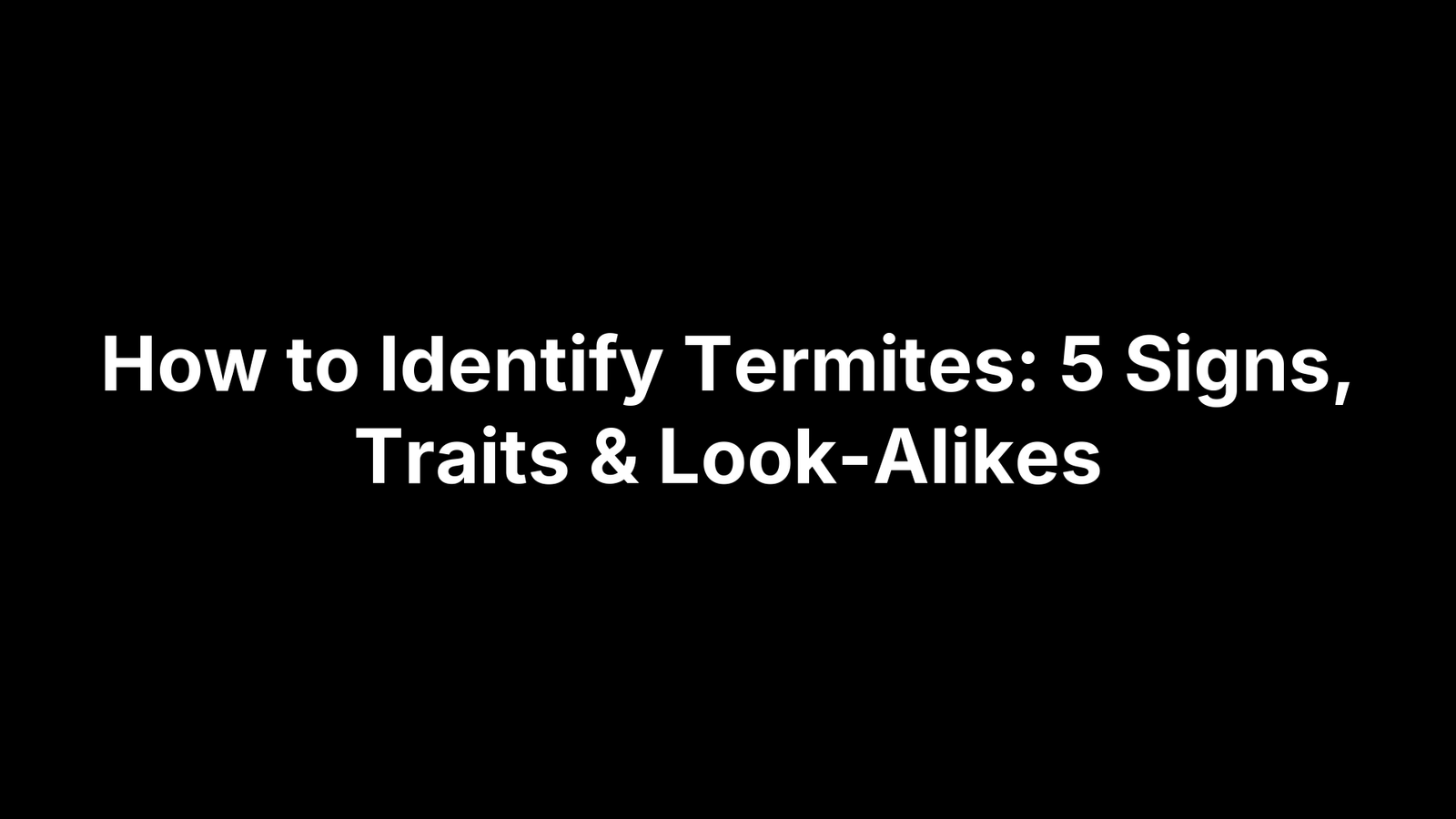A few tiny wings on the windowsill. A pencil-thin line of dried mud along the foundation. Wood that sounds oddly hollow when you tap it. Termites rarely announce themselves, but the clues they leave behind can add up to costly damage if you miss them. Whether you own a home or manage a building, early identification is the difference between a simple fix and major repairs, so knowing exactly what to look for matters.
This guide breaks down the five clearest ways to identify termites—what the evidence looks like, where it shows up, and how to confirm it isn’t something else. You’ll learn the telltale signs of swarmers and discarded wings, mud tubes and hidden wood damage, frass and tiny kick-out holes, and the key traits that separate termites from flying ants. For each sign, we’ll cover what it is, the key indicators, where to check, and practical next steps. Ready to get certainty fast? We’ll start with the most reliable move: a professional termite inspection.
1. Get a professional termite inspection from Redi Pest Control
When you need certainty fast, a licensed termite inspection is the most reliable way to confirm activity and stop damage early. Our pros know how to identify termites by finding the subtle, telltale evidence homeowners often miss and then producing a clear plan to eliminate the colony and prevent a repeat.
What it is
A comprehensive, top-to-bottom evaluation of your property that documents visible signs of termites and conditions that support them. Inspectors look for swarmers and discarded wings, mud tubes, hollow-sounding or damaged wood, frass with tiny kick-out holes, and moisture-related clues like peeling paint or drooping drywall—evidence widely recognized by national pest authorities.
Key indicators
During the inspection, your technician zeroes in on the most predictive markers of an active or previous infestation.
- Swarmers and wings: Winged termites and piles of shed wings near windows and doors.
- Mud tubes: Pencil-width earthen tubes along foundations and in crawl spaces.
- Compromised wood: Hollow sounds when tapped, crumbling areas, or maze-like galleries.
- Frass and pinholes: Drywood termite droppings and small “kick-out” holes.
- Moisture damage cues: Bubbling/peeling paint or discolored, sagging drywall.
Where to check
We focus on termite hot spots and pathways so nothing important gets overlooked.
- Foundation and exterior: Slab edges, stem walls, expansion joints, and utility penetrations.
- Crawl spaces and basements: Sill plates, joists, piers, and support posts.
- Interior finishes: Baseboards, window/door frames, drywall seams, and flooring.
- Attics and roof framing: Rafters and sheathing, where drywood termites often nest.
Next steps
You’ll receive clear findings, photos, and a customized plan. Because treatments differ by species (subterranean vs. drywood), we tailor the approach to your situation for effective elimination and long-term protection.
- Confirm species and activity: Identify termite type and extent of damage.
- Target the source: Implement treatment and establish a protective barrier.
- Prevent and monitor: Correct conducive conditions and set a monitoring schedule.
2. Swarmers and piles of discarded wings
If you’re seeing winged bugs at windows or tiny, translucent wings left behind on sills and floors, pay attention. Swarmers and the piles of discarded wings they shed are among the clearest early clues of termite activity, often appearing briefly in spring or fall and easy to miss.
What it is
Swarmers are reproductive termites that leave a mature colony to start a new one. Soon after flight, they shed their wings—often in small piles that resemble fish scales—especially near light sources and entry points. Indoors, swarmers and their wings often signal the beginning of an infestation.
Key indicators
- Winged termites present: Brief, coordinated flights, typically in spring or fall.
- Piles of wings: Translucent, fish-scale-like wings on sills and floors.
- Same-length wings: Both pairs equal length (unlike flying ants).
- Timing and brevity: Swarms are short events, often daytime; some species at dusk.
Where to check
- Windowsills and door thresholds: Especially near exterior doors and sliders.
- Around lights: Porch lights, garage entries, and indoor fixtures.
- Spider webs and corners: Wings often get trapped here.
- Along foundations: Exterior ledges and cracks where swarmers emerge.
Next steps
- Collect evidence: Save a few wings/bugs in a clear bag and take photos.
- Scan for more signs: Check nearby areas for mud tubes or hollow-sounding wood.
- Schedule an inspection: Prompt confirmation and treatment prevent structural damage.
3. Mud tubes and hidden wood damage
Subterranean termites are stealthy. They travel inside protective mud tubes and eat wood from the inside out, so the first clues are often outside on your foundation—or buried behind paint, drywall, and flooring. Knowing how to identify termites by their tubes and subtle damage helps you catch an infestation before repairs get expensive.
What it is
Mud tubes are pencil-width, brown, cylindrical tunnels termites build to move safely between soil and wood while conserving moisture. Hidden wood damage happens as termites hollow timbers, leaving thin surfaces that can make paint bubble, drywall droop, floors squeak, and wood sound hollow when tapped.
Key indicators
- Pencil-width mud tubes: Dry, brown, cylindrical lines on masonry or wood.
- Hollow-sounding wood: A papery echo when you tap baseboards or trim.
- Crumbling/soft spots: Wood that dents or flakes under light pressure.
- Maze-like galleries: Tunneling patterns inside boards, studs, or furniture.
- Finish failures: Peeling paint, discolored or drooping drywall, warped floors.
Where to check
Start at the ground and move inward, focusing on moisture-prone areas and wood-to-entry points.
- Foundations/slab edges and stem walls, especially cracks and seams.
- Crawl spaces/basements: Sill plates, joists, piers, and support posts.
- Utility penetrations: Around pipes, vents, and conduit.
- Garage/porch steps: Expansion joints and thresholds.
- Interior finishes: Baseboards, window/door frames, and along exterior walls.
Next steps
- Document evidence: Photograph tubes and damaged areas; note locations.
- Do not clean everything: Leave visible signs for your inspector to assess.
- Check nearby zones: Look for wings, frass, or additional tubes.
- Schedule a professional inspection: Prompt treatment stops colony activity and prevents further structural damage.
4. Frass and tiny kick-out holes
Tiny piles of pellet-like droppings beneath baseboards or furniture often mean drywood termites are active inside the wood. These piles—called frass—tend to collect below small “kick-out” holes where termites push debris out. Knowing how to identify termites by frass helps confirm species and urgency.
What it is
Drywood termites nest in the wood they infest and eject droppings (frass) through small kick-out holes, leaving visible piles nearby. Subterranean termites, by contrast, do not kick out feces and commonly build mud tubes to reach wood.
Key indicators
- Pellet-like frass: Small, granulated droppings in neat piles.
- Kick-out holes: Tiny openings in the wood above or beside the pile.
- Indoor placement: Piles at the base of trim, walls, or furniture.
- Seasonal context: Wings or swarmers nearby strengthen the evidence.
Where to check
- Baseboards, window/door frames, trim: Along interior edges and corners.
- Attics and roof framing: Rafters and wooden wall supports.
- Walls, furniture, flooring: Especially dry, finished wood pieces.
- Window sills and closets: Quiet areas where debris accumulates.
Next steps
- Save evidence: Collect a small sample and take close-up photos before cleaning.
- Trace upward: Look directly above piles for the kick-out hole in the wood.
- Book an inspection: Confirm species and scope; treatments differ for drywood vs. subterranean termites.
5. Termites vs flying ants: look-alikes and key traits
Seeing winged insects at a window can cause instant panic, but not every “termite” is one. Flying ants and termite swarmers appear similar at a glance, yet their bodies give them away. Knowing how to identify termites versus flying ants matters because treatments are completely different—and guessing wrong wastes time and money.
What it is
A quick visual comparison of body shape, antennae, wings, and legs can separate termites from flying ants on the spot. Termite swarmers shed same-size wings in small piles, while flying ants have a distinctly pinched waist and mismatched wing pairs. Use the checklist below to confirm what you’re seeing.
Key indicators
- Waist shape: Termites have a thick, uniform waist; ants have a narrow, pinched waist.
- Antennae: Termites’ antennae are straight; ants’ antennae are bent/clubbed.
- Wing length: Termites’ front and back wings are the same length; ants’ front wings are longer than the back.
- Legs: Termites have shorter legs; flying ants’ legs appear longer.
- After swarms: Termites leave piles of translucent, fish-scale-like wings near light and entry points.
Where to check
Confirm ID where swarmers gather and where wings collect so you don’t miss easy evidence.
- Windowsills and door thresholds
- Under indoor and porch lights
- Along baseboards near exterior walls
- On foundations and at utility penetrations
Next steps
- Collect a sample: Place an insect or several wings on white paper and photograph waist, antennae, and wing length.
- Cross-check signs: Look nearby for mud tubes, hollow wood, or frass to support your ID.
- Get confirmation: Schedule a professional inspection to verify species and map the best treatment plan.
What to do next
If any of these signs look familiar, act now. Termites work quietly but continuously, and early confirmation is the difference between a contained treatment and structural repairs. Here’s how to turn clues into certainty and a fix without accidentally erasing the evidence that helps your technician pinpoint the problem.
- Document everything: photograph tubes, wings, frass, and damaged areas; save a small sample in a bag.
- Recheck nearby hot spots: foundations, crawl spaces, baseboards, and window/door frames.
- Leave evidence in place: avoid cleaning, patching, or painting over tubes, holes, or stains before inspection.
- Schedule a professional termite inspection to confirm species and map activity.
- Follow the plan: treat the source, establish protection, correct conducive conditions, and set monitoring.
Need help now? Book your professional termite inspection with Redi Pest Control.


